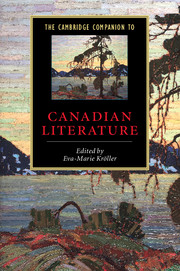Book contents
- Frontmatter
- Introduction
- 1 Aboriginal writing
- 2 Francophone writing
- 3 Exploration and travel
- 4 Nature-writing
- 5 Drama
- 6 Poetry
- 7 Fiction
- 8 Short fiction
- 9 Writing by women
- 10 Life writing
- 11 Regionalism and urbanism
- 12 Canadian literary criticism and the idea of a national literature
- Further reading
- Index
- Series List
9 - Writing by women
Published online by Cambridge University Press: 28 May 2006
- Frontmatter
- Introduction
- 1 Aboriginal writing
- 2 Francophone writing
- 3 Exploration and travel
- 4 Nature-writing
- 5 Drama
- 6 Poetry
- 7 Fiction
- 8 Short fiction
- 9 Writing by women
- 10 Life writing
- 11 Regionalism and urbanism
- 12 Canadian literary criticism and the idea of a national literature
- Further reading
- Index
- Series List
Summary
Setting down her title
“Setting down her title” This phrase, taken from a Canadian woman's novel written in the early 1970s, addresses the double issue of women's writing and its relationship to wider feminist questions of women's literary and political entitlement. It also marks a significant starting point for this chapter, which will focus on Canadian women's fiction in English since the late 1960s, the period when Canadian writing achieved high visibility at home and abroad. At the present time Margaret Atwood, Alice Munro, and Carol Shields, who all started publishing in the 1960s and 70s, are names that are synonymous with Canadian writing internationally. In addition, since the early 1990s a constellation of new women writers, including many from a wide range of ethnic and racial backgrounds, has enormously diversified Canada's literary image, and these women's novels and short stories feature in increasing numbers on international publishers' lists. Why should this be? What is so distinctive about these writers? And what factors have contributed to their popularity and visibility?
- Type
- Chapter
- Information
- The Cambridge Companion to Canadian Literature , pp. 194 - 215Publisher: Cambridge University PressPrint publication year: 2004
- 3
- Cited by

